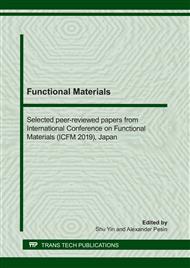[1]
B. Henriques, D. Soares and F.S. Silva, Influence of preoxidation cycle on the bond strength of CoCrMoSi-porcelain dental composites, Mater. Sci. Eng. C. 32 (2012) 2374-2380.
DOI: 10.1016/j.msec.2012.07.010
Google Scholar
[2]
M. Niinomi, Recent metallic materials for biomedical applications, Metall. Mater. Trans. A. 33 (2002) 477-486.
DOI: 10.1007/s11661-002-0109-2
Google Scholar
[3]
C. Peaubuapuan, P. Tunthawiroon, K. Kanlayasiri, C. Yuangyai, Effect of Si on Microstructure and Corrosion Behavior of CoCrMo Alloys, IOP Conf. Ser. Mater. Sci. Eng. 361 (2018).
DOI: 10.1088/1757-899x/361/1/012004
Google Scholar
[4]
B. Henriques, F.S. Silva and D. Soares, Analysis of CoCrMo Surface Oxide Removal by Alumina Blasting before Porcelain Firing in Dental Restorations, Mater. Sci. Forum. 730–732 (2012) 9-14.
DOI: 10.4028/www.scientific.net/msf.730-732.9
Google Scholar
[5]
P. Tunthawiroon, Y. Li, N. Tang, Y. Koizumi and A. Chiba, Effects of alloyed Si on the oxidation behaviour of Co–29Cr–6Mo alloy for solid-oxide fuel cell interconnects, Corros. Sci. 95 (2015) 88-99.
DOI: 10.1016/j.corsci.2015.02.036
Google Scholar
[6]
P. Tunthawiroon, Y. Li and A. Chiba, Influences of alloyed Si on the corrosion resistance of Co- Cr-Mo alloy to molten Al by iso-thermal oxidation in air, Corros. Sci. 100 (2015) 428-434.
DOI: 10.1016/j.corsci.2015.08.014
Google Scholar
[7]
H. Buscail, C. Issartel, F. Riffard, R. Rolland, S. Perrier, Influence of various gaseous environments on SiO2 formation on the 330Cb (Fe-35Ni-18Cr-1Nb-2.15Si) alloy at 900°C, Corros. Sci. Vol. 65 (2012) 535-541.
DOI: 10.1016/j.corsci.2012.08.066
Google Scholar
[8]
K. Yamanaka, M. Mori and A. Chiba, Surface characterisation of Ni-free Co-Cr-W-based dental alloys exposed to high temperatures and the effects of adding silicon, Corros. Sci. 94 (2015) 411-419.
DOI: 10.1016/j.corsci.2015.02.030
Google Scholar
[9]
K. Nii, High-temperature oxidation of alloys, Corros. Eng. 26 (1997) 389-400.
Google Scholar
[10]
Y. Li, N. Tang, P. Tunthawiroon, Y. Koizumi and A. Chiba, Characterisation of oxide films formed on Co–29Cr–6Mo alloy used in die-casting moulds for aluminium, Corros. Sci. 73 (2013) 72-79.
DOI: 10.1016/j.corsci.2013.03.026
Google Scholar
[11]
Y. Kamigaki, Y. Itoh, Thermal oxidation of silicon in various oxygen partial pressures diluted by nitrogen, J. Appl. Phys. 48 (1977) 2891-2896.
DOI: 10.1063/1.324099
Google Scholar
[12]
P.K. Kofstad, A.Z. Hed, Oxidation of Co-25 w/o Cr at high temperatures, J. Electrochem. Soc. 116 (1969) 1542-1550.
DOI: 10.1149/1.2411603
Google Scholar
[13]
L. Leyssens, B. Vinck, C. Van Der Straeten, F. Wuyts and L. Maes, Cobalt toxicity in humans-A review of the potential sources and systemic health effects, Toxicology.387 (2017) 43-56.
DOI: 10.1016/j.tox.2017.05.015
Google Scholar


